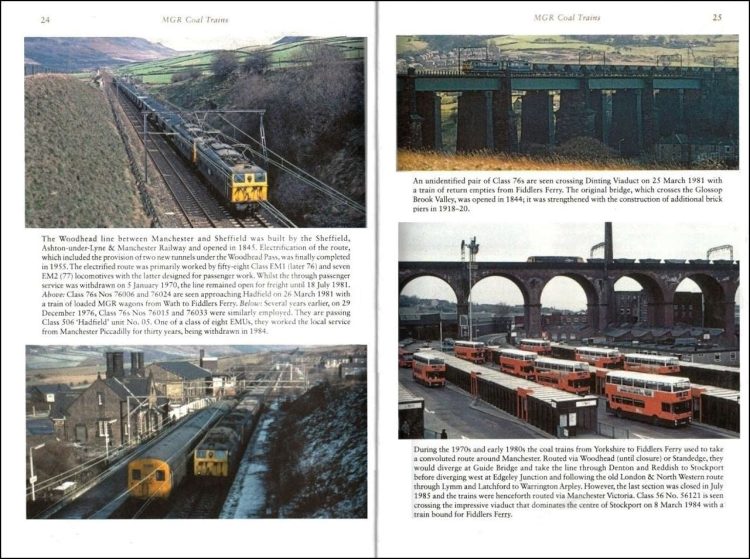This book is as much a historical archive as a fascinating memory of what was an everyday scene just a few years ago and illustrates Merry-Go-Round coal trains in a wide variety of locations from 1968 onwards.
Published in February 2023 by Amberley Publishing and written by Peter J. Green, this soft cover book measures around 23.4 cm x 16.5 cm, and has 96 pages and 180 illustrations. It has a published price of £15.99 although Amberley Publishing currently has it on offer at £14.39, and at the time of writing, it can be obtained from Amazon for £10.99.
As electricity became more widely used to power and light Britain's towns and cities a number of municipal boroughs built their own power stations. However, during the 1960s and early 1970s the government constructed a number of giant power stations that required a continuous flow of coal trains to feed their hungry furnaces. With their direct rail connections, they were ideally suited to the concept of the Merry-Go-Round, or MGR, coal train, but the rapid demise of coal-fired power stations in the last ten years has largely consigned MGR coal trains to history.
This book will resurrect what was until a few years ago a familiar scene throughout the UK. Of particular interest are photographs of Class 76 electrics hauling MGR coal trains on the Woodhead route between Manchester and Sheffield. Both the Class 76s and the Woodhead route in its entirety are now consigned to history, although the sections of the route in the images below still remain operational.

Many MGR coal trains were hauled by Class 56 locomotives, and the photographs below are typical of the time.
In 1996, English Welsh and Scottish (EWS) railways placed an order with General Motors for 250 Class 66 locomotives to be built at its factory in London, Ontario in Canada. They were ideally suited for use on MGR coal trains, and other operators ordered their own examples. The images below show Class 66s from four different operators, with an EWS version at the top left, Fastline at the bottom left, Freightliner at the top right and one in GB Railfreight livery at the bottom right.
Another type of locomotive that became synonymous with MGR coal trains was the Class 58, as seen on the left-hand page below. Barrow Hill near Chesterfield in Derbyshire is a location that was once a base for servicing locomotives used on MGR trains but has been transformed into an imposing establishment as a working museum. At the top right are four Class 20 locomotives that were used in pairs when hauling MGR trains, whilst at the bottom right are a Class 56 and three Class 58s grouped around Barrow Hill's turntable when it was still in use as a maintenance base.
No book about MGR coal trains would be complete without at least one photo of giant cooling towers at the power stations fed by the trains. One such station is Ratcliffe-in-Soar, seen at the top left. The image at the bottom left shows a train of bogie hopper wagons, which were introduced in 2001 and had a capacity of 74.5 tonnes compared with the 32 tonnes capacity of their four-wheel predecessors.
What was once the frequent sight of long trains of identical wagons full of coal has now largely vanished from the British railway scene. “MGR Coal Trains” by Mike Rhodes brings those scenes back to life, with images from a surprisingly wide variety of locations. Photos of long trains of identical wagons crossing Garsdale and Ribblehead viaducts on the Settle and Carlisle line are particularly impressive.
A very informative Introduction describes the history of MGR wagons and the depots that were specially built to maintain them. It also includes a list of power stations served by MGR trains, and their source of coal, which in some cases seemed to defy reason such as Cottam and Ratcliffe-on-Soar in Nottinghamshire receiving coal from Scotland.
As is to be expected, most photos in the book show MGR trains hauled by Class 56, 58, 60, and 66 locomotives, but there are others including Classes 20, 37, 47, 59, 70 and 76, as well as a solitary example of a Class 26 in Scotland. Adding to the variety of images are several showing locomotives undergoing maintenance or stabled awaiting their next turn of duty.
In general, the photos are well composed and give a good appreciation of what an impressive sight these trains were. This is a book that will be sure to bring back memories of these impressive trains, and will be a useful addition to any railway enthusiast's bookshelf.
The book is available to purchase from Amazon and from Amberley Publishing.
We would like to thank Amberley Publishing for providing us with a copy of the book for review.